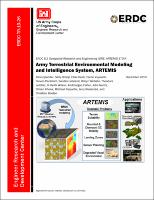Please use this identifier to cite or link to this item:
https://hdl.handle.net/11681/35093Full metadata record
| DC Field | Value | Language |
|---|---|---|
| dc.contributor.author | Eylander, John B. | - |
| dc.contributor.author | Shoop, Sally A. (Sally Annette) | - |
| dc.contributor.author | Deeb, Elias J. | - |
| dc.contributor.author | Vuyovich, Carrie M. | - |
| dc.contributor.author | Peckham, Steven E. | - |
| dc.contributor.author | LeGrand, Sandra L. | - |
| dc.contributor.author | Barbato, Robyn A. | - |
| dc.contributor.author | Letcher, Theodore W. | - |
| dc.contributor.author | Wilson, D. Keith | - |
| dc.contributor.author | Fisher, Andmorgan R. | - |
| dc.contributor.author | Nedza, John A. | - |
| dc.contributor.author | Khona, Dhiren S. | - |
| dc.contributor.author | Paquette, Michael A. | - |
| dc.contributor.author | Bieszczad, Jerry | - |
| dc.contributor.author | Borden, Christian | - |
| dc.date.accessioned | 2020-01-08T16:02:20Z | - |
| dc.date.available | 2020-01-08T16:02:20Z | - |
| dc.date.issued | 2019-12 | - |
| dc.identifier.govdoc | ERDC TR-19-26 | - |
| dc.identifier.uri | https://hdl.handle.net/11681/35093 | - |
| dc.identifier.uri | http://dx.doi.org/10.21079/11681/35093 | - |
| dc.description | Technical Report | - |
| dc.description.abstract | The Army Terrestrial Modeling and Intelligence System, ARTEMIS, research program focused on developing innovative methods of fusing weather data from authoritative sources with geospatial content and services to fill a number of identified Army capability gaps. The tools developed within the ARTEMIS research program can support operations anywhere in the world, supporting Army Global Land Operation’s needs. We overcame technology challenges that limited the use of gridded weather products and digital terrain products with Army tactical decision aids, providing relevancy to the impacts of weather and terrain on military operations beyond the current methods of delivering weather impacts on the battlefield via PowerPoint briefings. The project benefited from the recent availability of higher-resolution global soil texture, digital elevation models, and land use and land cover datasets provided by the National Geospatial-Intelligence Agency. Teams working on the ARTEMIS research program developed tools and capabilities that integrated weather digital products into the Army Geospatial Enterprise–compliant systems to deliver fused all-weather and all-season military decision aids (e.g., maneuver, austere entry, sensor performance, and other typical terrain analysis tasks) in a method that supports risk-based assessments. | en_US |
| dc.description.sponsorship | United States. Office of the Assistant Secretary of the Army for Acquisition, Logistics, and Technology. | en_US |
| dc.description.sponsorship | ERDC 6.2 Geospatial Research and Engineering ARTEMIS STO-R Program (U.S.) | - |
| dc.description.tableofcontents | Abstract .......................................................................................................................................................... ii Figures and Tables ........................................................................................................................................ iv Preface ............................................................................................................................................................ vi Acronyms and Abbreviations .....................................................................................................................vii Executive Summary .......................................................................................................................................x What was the problem? ............................................................................................................ x What barriers did we overcome to solve this problem? ......................................................... xi How did we overcome those barriers? ................................................................................... xii What are the capabilities we developed? ............................................................................. xiii Quantitative metrics ............................................................................................................... xiv Transitions ............................................................................................................................... xv Teams and laboratories ......................................................................................................... xvi 1 Introduction ............................................................................................................................................ 1 1.1 Background ..................................................................................................................... 1 1.2 Objective .......................................................................................................................... 2 1.3 Approach ......................................................................................................................... 3 2 Technical Description ........................................................................................................................... 7 2.1 Models ............................................................................................................................. 8 2.1.1 Description of approach .......................................................................................................... 8 2.1.2 Terrain analysis numerical modeling testbed ........................................................................ 8 2.1.3 Snow remote-sensing and numerical-modeling research ................................................... 12 2.2 Terrain phenomenology research ................................................................................ 18 2.2.1 Dust research ......................................................................................................................... 18 2.2.2 Biosentinels research ............................................................................................................ 21 2.3 Weather-informed mobility ........................................................................................... 23 2.4 Remote assessment for ingress/egress locations ..................................................... 26 2.5 Sensor performance ..................................................................................................... 29 2.5.1 Improved acoustics in EASEE ................................................................................................ 29 2.5.2 EASEE Web Services design .................................................................................................. 34 2.5.3 Integration of a four-dimensional weather system support to EASEE ................................ 35 2.6 Validation of tools and quantitative metrics ................................................................ 38 3 Summary of ARTEMIS Major Accomplishments .......................................................................... 42 3.1 Technical Transitions .................................................................................................... 43 3.2 Using ARTEMIS tools for direct Army support.............................................................. 44 4 Conclusion ............................................................................................................................................ 45 References ................................................................................................................................................... 47 Report Documentation Page | - |
| dc.format.extent | 73 pages / 4.882 Mb | - |
| dc.format.medium | PDF/A | - |
| dc.language.iso | en_US | en_US |
| dc.publisher | Cold Regions Research and Engineering Laboratory (U.S.) | en_US |
| dc.publisher | Geospatial Research Laboratory (U.S.) | - |
| dc.publisher | Engineer Research and Development Center (U.S.) | - |
| dc.relation.ispartofseries | Technical Report (Engineer Research and Development Center (U.S.)) ; no. ERDC TR-19-26 | - |
| dc.rights | Approved for Public Release; Distribution is Unlimited | - |
| dc.source | This Digital Resource was created in Microsoft Word and Adobe Acrobat | - |
| dc.subject | Computer programs | en_US |
| dc.subject | Geographic information systems | en_US |
| dc.subject | Geospatial data | en_US |
| dc.subject | Meteorology | en_US |
| dc.subject | Remote-sensing images | en_US |
| dc.title | Army Terrestrial Environmental Modeling and Intelligence System, ARTEMIS | en_US |
| dc.type | Report | en_US |
| Appears in Collections: | Technical Report | |
Files in This Item:
| File | Description | Size | Format | |
|---|---|---|---|---|
| ERDC TR-19-26.pdf | 5 MB | Adobe PDF |  View/Open |